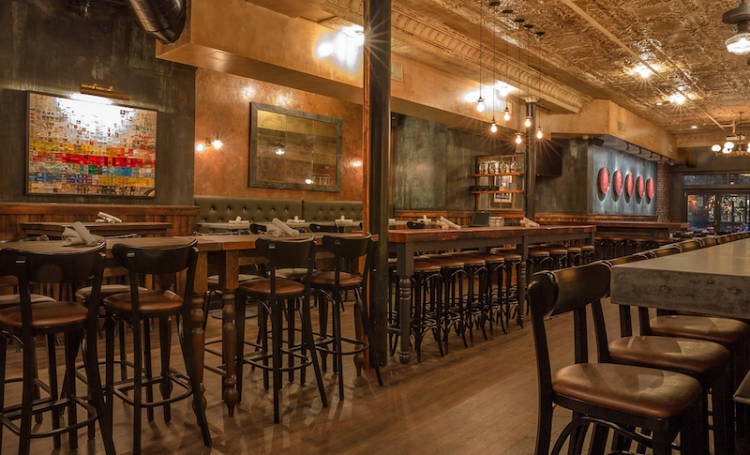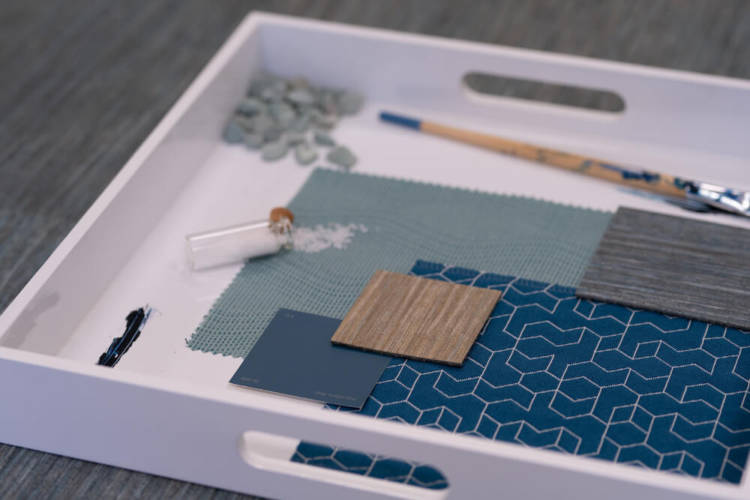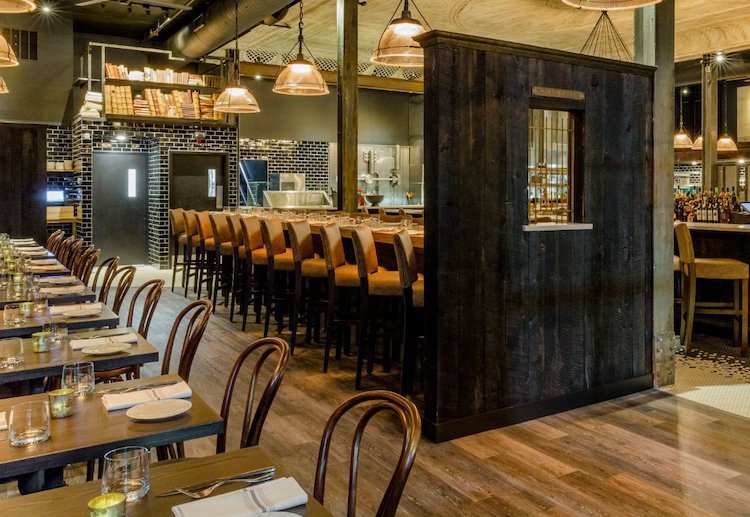08 Jun, 2022
7 Restaurant Design Trends to Watch in 2022
It’s no secret that the restaurant industry had to pivot in a major way in 2020. From the prevalence of outdoor dining to the convenience of curbside pickup, eateries and dining establishments had to make quick business decisions to continue operating. Some of these pivots evolved into trends that will likely stick around for the foreseeable future.
At its core, restaurant design is all about creating a holistic dining experience for the customer. Whether it’s the entryway of the establishment, the communal seating area of a private dining space, or the energy of the bar, every component of restaurant design is purposeful.
As digital transformation has changed the way we consume information, what it means to have a “dining experience” has also changed thanks to COVID-19. But now, as restaurants look to adapt to current circumstances (and think about the future), many are designing for safe, social interactions while still inspiring customers with aesthetics. Everything from the design scheme and flooring to the furniture and finishes can create a positive, comforting dining environment. And that’s just the tip of the iceberg when it comes to restaurant design innovations.
To help enhance the safe and enjoyable dining experience for your customer (and to help stay ahead of the competition), we invite you to explore these 2022 restaurant design ideas and trends that are shaping the industry.
- Restaurants Everywhere Need to Feel Safe & Comfortable
- A Variety of Dining Options
- Texture, Texture, Texture
- Local Flavor
- On-Brand Design and Storytelling
- Warmer Palettes
- Increased Online Presence
1. Restaurants Everywhere Need to Feel Safe & Comfortable
Dining out took a big hit in 2020 as restaurants were either forced to close or modify their business model. Now, as they look to make up ground in 2022, attract new customers and retain current ones, restaurants of all sizes need to cater to design and culinary trends in a way that makes consumers feel safe and comfortable.
Many restaurants have expanded their outdoor dining options (when weather permits) and have added plexiglass barriers between booths and wayfinding signs encouraging patrons to socially distance.
Others are turning to technology. Contactless payment methods, such as QR codes and online checkout, are convenient options that limit in-person contact.
Restaurants have also been forced to rethink their approach when it comes to seating due to capacity restrictions, social distancing and safety protocols. Many places have added curbside pickup, free delivery and takeout options.
In addition to outdoor seating (and in some cases, outdoor dining bubbles), restaurants may opt for a less-cluttered look, especially if they need to place tables 6 feet away from each other. A variety of traditional furnishings, however, are still relevant (such as seating in waiting areas), though some of these may have to be adjusted.
The open kitchen/floor plan concept has also become a nontraditional alternative to traditional restaurant design, but now some restaurants are trying to balance the open concept while installing safety measures such as barriers and partitioned spaces.
These modifications may still allow customers to see “behind the scenes” and feel as if they are part of the cooking and preparation experience.
Flooring is another interior design solution that can be used to delineate space and define safe social distance. Two of the most regularly used commercial flooring options are LVT and engineered hardwood. Both are great options for restaurant dining rooms and lobby areas in which customers congregate to place orders or wait to be seated.
Since sanitation and cleanliness is more important than ever, engineered hardwood and LVT are ideal because they’re simple to maintain and easy to clean. Both flooring materials are also durable enough for most spills and messes.
LVT and engineered hardwood can also withstand the daily wear and tear of foot traffic, and they can be replaced easily with minimal disruption. This means that restaurants won’t have to close or shut down certain spaces when maintenance is needed.
2. A Variety of Dining Options
Both fine dining and quick service restaurants have now expanded their options beyond in-person dining and takeout to include contactless pickup, meal kits and virtual cooking classes.
According to the National Restaurant Association, more than half of adults said they would likely buy a meal kit if it was offered by one of their favorite restaurants.
Mei Mei in Boston offers prepared foods and virtual cooking classes. In addition to their regular takeout menu, Throwback Brewery in Hampton, NH offers 4-serving take home meals for delivery on Thursday and for pickup several days of the week. Bartolini’s in Chicago offers nationwide shipping so you can recreate a deep dish-style pizza from the comfort of your own kitchen.
Third-party delivery services, such as Grubhub and Doordash, are also popular; 31% of people use them at least twice a week.
Self-service kiosks continue to be a popular option at quick service chains and restaurants such as Panera and McDonald’s. According to Forbes, “more than 65% of customers said they would visit a restaurant more often if self-service kiosks were offered, and 30% of customers prefer to order from a kiosk versus a cashier if the lines were of equal length.”
Since online ordering and pickup has significantly increased, many businesses have designated contactless areas within their stores to cater to those customers who are picking up food. This convenience makes it easy for on-the-go customers to stop by without having to flag down an employee.
For example, Panera users can opt for the “Rapid Pick-Up” option in which they order and pay online and specify the pick-up time. The order will be waiting in a designated spot in the Panera location of their choosing. And for those who aren’t in a rush and want to order in-person from a cashier? That original option is still preferred by many, showing that Panera has adapted to those on-the-go customers while still maintaining their sit-down bakery-café environment.
3. Texture, Texture, Texture
 Texture is here to stay as restaurants interior design trends are seeing a greater focus on mixing and layering different textures and finishes. But now many are opting for long-lasting textures that are easy to clean and sanitize.
Texture is here to stay as restaurants interior design trends are seeing a greater focus on mixing and layering different textures and finishes. But now many are opting for long-lasting textures that are easy to clean and sanitize.
Flooring is one easy way to add texture. Restaurant flooring is an important design choice, as it must be highly functional — think durability to traffic and spills — with strong aesthetic qualities. Options like LVT offer natural water and scratch resistant properties while mirroring the look of wood, stone, concrete and other abstract finishes, while engineered hardwood provides the same durability and ease of use with a natural texture.
Texture can also be easily incorporated via unique furnishings, textiles and lighting. For example: pairing various patterned fabrics and plush textiles with a contemporary wood or wood-look flooring design; or combining mixed metal lighting fixtures with concrete-like flooring and wall finishes. To complete a space, unique décor, artwork and wall treatments provide an added layering element to enhance the overall depth of the space.
“I see a lot of full-finish texture, and a lot of texture that lends itself to natural elements,” said Markus Sebastiano, a renowned artist based in Massachusetts. “Whether it’s a two-color plaster or a sheen over plaster or copper-tainted wall, people are now reaching into the past and using the past as inspiration.”
Finally, the use of organic features is growing in popularity in hospitality environments, and the restaurant industry is no exception. Adding live wall treatments or water features enhance dining spaces and lobbies with a texturized, yet natural visual.
4. Local Flavor
People love dining out, and they especially enjoy it when it is a delicious, enjoyable experience. But they want just that — the experience. In fact, the National Restaurant Association estimates that about two-thirds of consumers (63%) would rather spend money on an experience than a product. Those numbers may be down due to COVID-19, but as restrictions lift and restaurants make accommodations to welcome larger crowds, consumers may be looking to their favorite eateries as an excuse to get out of the house.
Restaurants need to be memorable. A shift in design, particularly in chain restaurants and even restaurant spaces located in historic or destination areas, is the incorporation of local area icons and landmarks. Locally sourced ingredients and specialties have been hot for a while, but now we’re seeing the physical space reflect the community, too. For example, Ledger Restaurant & Bar in Salem, MA, which contains Parterre products, is located in an old bank building from the 1800s, incorporating various features like a large safe into the interior design approach.
Some restaurants are adding artwork from local artists, like at Elm Street Taproom in Boston. Sebastiano created much of the artwork used in this space, and he has a unique process that inspires his local installations. “I start by digging into the archives and going to the local library to learn more about what the area is known for,” he says. “What do locals talk about, what would be popular symbolism?”
To reflect local flare while keeping a touch of elegance, consider including décor that fits in with the area — from archiving antique furnishings created within the community, to featuring local artists’ work, or using resources and materials that are native to the local environment, such as hardwood or wood-look flooring that is derived from or inspired by the local natural environment.
5. On-Brand Design and Storytelling
Telling stories is more important than ever. According to HubSpot, “[…] if you can craft a compelling brand story, your audience will remember who you are, develop empathy for you, and, ultimately, care about you.”
In 2022, on-brand design and storytelling also needs to incorporate an element of safety and comfort. When customers walk across the threshold of a restaurant, they scan the area and take in the design and overall aesthetic; and now, whether it’s conscious or otherwise, they’ll also be thinking about whether the space is safe — and you want them to have a positive, lasting impression once they leave.
It’s also important to remember that people still connect to other people — and to stories. Statistics and data are important but can sometimes overwhelm or tire customers. “A great story helps your audience find personal and emotional connections to your brand, thus making your brand more personable,” according to Next Restaurants. “Stories affect audiences and are easy to remember, keeping your brand in your customer’s mind. Plus, when a customer sees a great story on social media, they’re more likely to share it, increasing your reach.”
The bottom line: It’s important that your design and story are authentic and true to your brand.
6. Warmer Palettes
Warmer palettes continue to shine in retail design, especially lighter hues that instill feelings of hominess and comfort while simultaneously providing a sense of cleanliness. Warm colors also pair well with neutrals.
Color palettes have shifted from a cool base to more rich, warm tones like deep reds, golden yellows or burnt orange. In fact, these colors have actually been shown to increase people’s heart rate and excitement, which stimulates hunger, making them more likely to order more food.
“Warm tones are growing in popularity as the gray bases that have been so popular this past decade begin to transition into browns. Warmer tones are welcoming and inviting and help ensure diners are comfortable as they enjoy their meals,” said Erika Woelfel, Vice President of Colors and Creative Services at Behr. “Dining in particular is a great opportunity to disconnect, and colors found in nature can help customers relax and enjoy their company, rather than their devices.”
Designing around a warm palette – wall color, seating, flooring and décor – can provide a more intimate, inviting experience for patrons. Also, warmer tones and décor make for more Instagram-worthy photo backdrops that customers will love to share.
7. Increased Online Presence
COVID-19 has pushed restaurants to up their online presence game as they pivot to stay relevant and connect with customers. For example, Yelp users can now filter restaurants by curbside pickup or virtual tasting sessions. Many eateries have created online ordering or added ordering options to their app.
Social media continues to dominate the digital scene, but it’s also a useful way for restaurants to communicate with consumers.
About 3.48 billion people now use social media, according to Hootsuite, and the average American user has 7.1 social media accounts. From fine dining establishments and fast food chains to boutique bakeries and breweries, social media is rampant across the restaurant industry.
Now, restaurants are using social media to explain safety protocols and make important announcements, such as menu updates, a change in hours or whether they are closed.
In addition to maintaining regular social media accounts, restaurants can also pay to advertise on popular platforms such as Instagram and Facebook.
Social media also allows users to experience a restaurant before they even step inside the door. They can look at pictures of the restaurant’s design aesthetic, and of the food (either from the restaurant’s own social media account or from others who have posted content and tagged the location).
How valuable is a picture on social media? According to Aglowid, “86% of millennials will try a new restaurant after seeing food-related content online.”
—
If you’re getting ready to begin a new restaurant design or remodel, consult some of our case studies recently finished restaurant and hospitality industry projects. These highlights outline where and how designers got their inspiration and explain why they turned to Parterre LVT or engineered hardwood.
